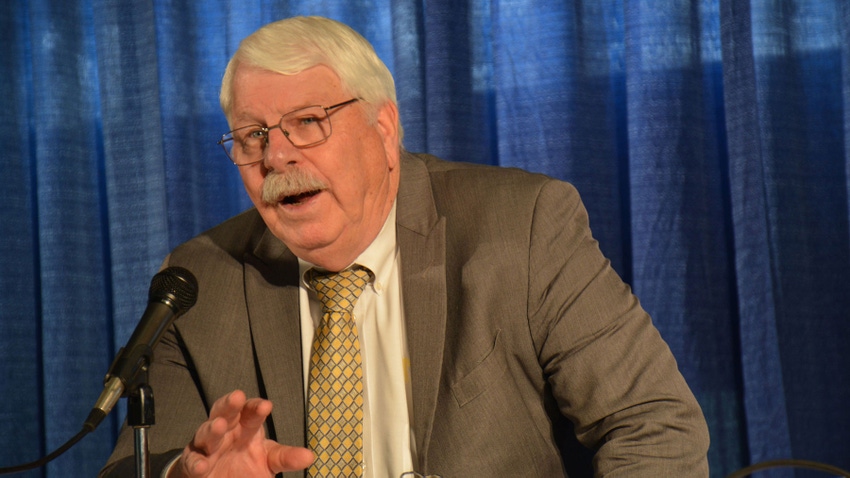
North Carolina Agriculture Commissioner Steve Troxler remains confident that 2022 will be the year when agriculture reaches his long-stated goal of being a $100 billion industry in the Tar Heel State.
“You’ve heard me say over and over again that I’m looking at this to be a $100 billion industry, so I am crossing my fingers that between the high input costs last year and more manufacturing of ag products moving into North Carolina, pretty good production levels, and pretty good prices for commodities, this past year may be the year that we do it. But it won’t show up in the next figures. These figures stay about two years behind, but I’ve just got a sneaky suspicion that we have done it, and I am going to be so proud,” Troxler said.
Delivering his annual State of North Carolina agriculture address during the Ag Development Forum Feb. 2 at the Southern Farm Show at the State Fairgrounds in Raleigh, Troxler said agriculture and agribusiness remain the strong economic drivers that they have always been. Agriculture and agribusiness remains North Carolina’s largest industry, with the latest official number valuing the industry at $92.9 billion, just $7 billion short of the commissioner’s $100 billion goal.
Troxler said agriculture remains a strong and vibrant industry in North Carolina. But he said there are challenges. Troxler said the greatest challenge now is population dynamics.
“I’m a person that loves the state of North Carolina, and I want to see us be at the top of statistical categories. But now I’m going to tell you some that are problematic. We are number three in the nation as far as population moving into North Carolina. We moved in I think about 135,000 people into this state just last year,” Troxler said.
“Raleigh ranks number two in the nation as far a growth of population of cities. Charlotte is at number six, so you put that all together, that means we have a really changing dynamic of population in this state. And that’s going to impact agriculture and agribusinesses, there is no question,” he said.
“The good news is these are mouths to feed. And we can do that. Our local food economy is great. We can feed these people, and I hope we get them hooked on local products, North Carolina products, and that’s going to be good.”
Troxler said North Carolina will remain a largely rural state, but he said he is very concerned about the continued loss of farmland as the state continues to gain both new population and new industry.
“The American Farmland Trust did a study, and North Carolina remains number two in the nation in the probability of the disappearance of farm and forestry land between now and the year 2040, not too far away. What that means is if we keep losing natural resources at the rate we are losing right now, that we are probably going to hit a point of diminishing returns in agriculture and agribusinesses in this state,” Troxler warned.
“If you don’t have the acres, and you don’t have the forestry products, then it’s not going to contribute to the economic well-being of North Carolina. And this is a sad, sad situation.”
Troxler said the North Carolina Department of Agriculture and Consumer Services is doing its best to try to stem the loss of farm and forestland across the state. He noted that the state did put 30,000 acres of protected farm and forestland into permanent conservation easements in the trust fund last year.
“That’s a lot of land. But it is small in the comparison to land we have lost to solar development and are now losing to housing development and the business development is unbelievable — the mega sites we are putting in North Carolina. And we’re in the running for 18 major economic projects for North Carolina; these are big, big projects.”
Troxler emphasized that rapid population growth will remain a major problem in North Carolina unless the state decides that farmland preservation is a priority, and that smart growth is used to protect valuable farmland across the state. “It can’t be sporadic. And it can’t take the farm and forestland away that we so desperately need.”
As he announced at the North Carolina Commodities Conference held at the Sheraton Imperial Hotel in Durham Jan. 12, Troxler once again said he will ask the North Carolina legislature for $15 million recurring for farmland preservation in North Carolina.
About the Author(s)
You May Also Like






